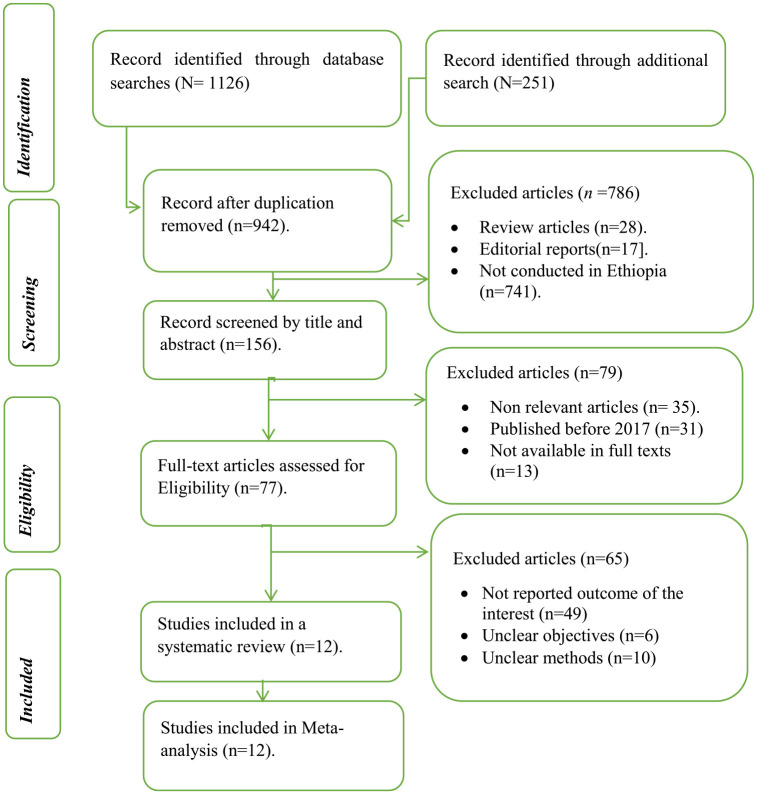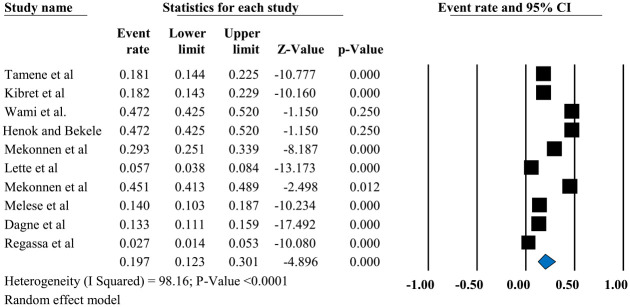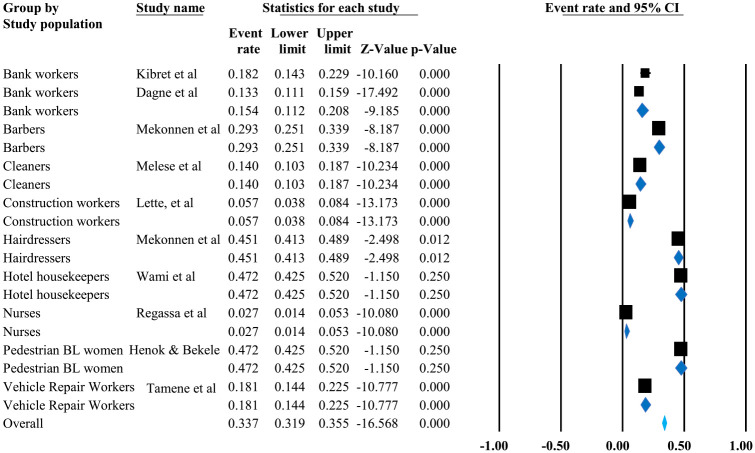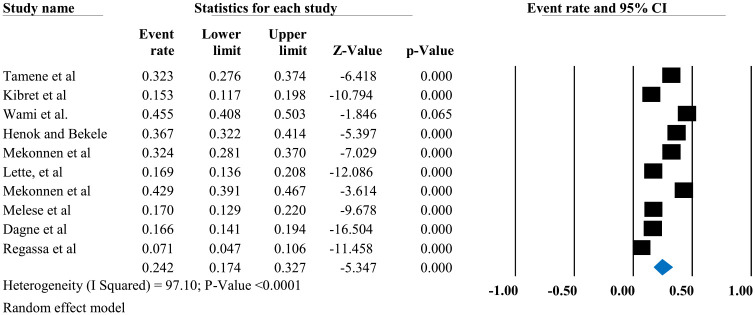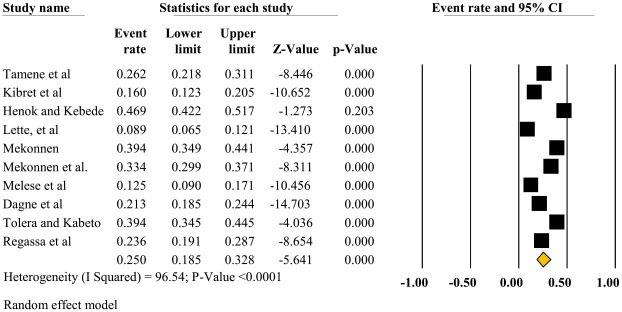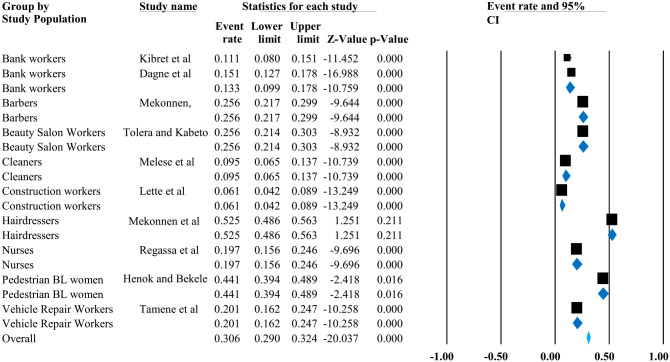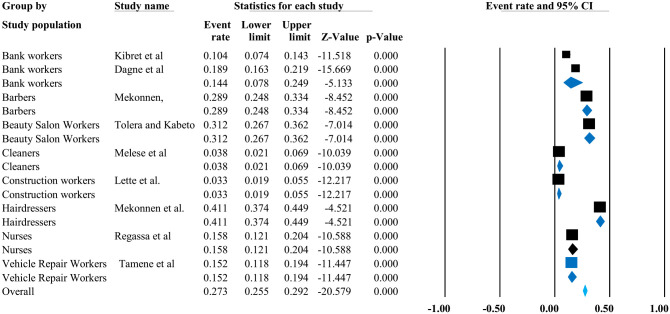Abstract
Background:
Currently, work-related musculoskeletal disorders are a significant public health concern and are a leading cause of disability-adjusted life years and reduced quality of life worldwide. In developing countries, including Ethiopia, as a result of poor occupational health and safety practices and underreporting of the problems, work-related musculoskeletal disorders have been increased, remaining less prioritized, and there is no adequate evidence on the prevalence of musculoskeletal disorders. Thus, the current study aimed to determine and provide the overall prevalence of occupational-related upper and lower extremity musculoskeletal pain among the working population of Ethiopia.
Methods
The current study considered full-text articles conducted in Ethiopia, written in English, and published from 2017 to 2020. Ten electronic databases: PubMed/MEDLINE, Web of Science, SCOPUS, Google Scholar, MedNar, Embase, CINAHL, Cochrane Library, African Index Medicus, and African Journals Online database were used to search the articles using a combination of Boolean logic operators (AND, OR, and NOT), Medical Subject Headings, and main keywords. The quality assessment of the articles was performed using the Joanna Briggs Institute Critical Appraisal tools to determine the relevance of the article to the current study.
Results:
Of the 1377 articles identified from the included electronic databases, 12 studies were included in the systematic review and meta-analysis. The study found that the pooled prevalence of occupational-related elbow pain, wrist/hand pain, knee/leg pain, foot/ankle pain, and hip/thigh pain in the previous one year was 19.7% (95% CI: 12.3, 30.1), 24.2% (95% CI: 17.4, 32.7), 25.0% (95% CI: 18.5, 32.8), 20.2% (95% CI: 12.8, 30.4), and 15.5% (95% CI: 9.9, 23.4), respectively. Based on a subgroup analysis, the last year’s pooled prevalence of occupational-related elbow, wrist/hand, knee/leg, foot/ankle, and hip/thigh pain was increased to 33.7% [95% CI: 31.9, 35.5], 29.7% [95% CI: 28.2, 31.2], 31.5% [95% CI: 29.9, 33.2], 30.6% [95% CI: 29.0, 32.4], and 27.3% [95% CI: 25.5, 29.2], respectively.
Conclusion:
Occupational-related musculoskeletal disorders continue to have a potential impact on workers’ health and productivity. The current study found that the overall pooled prevalence of occupational-related upper and lower extremity musculoskeletal disorders in the last year ranged from 15.5 to 33.7%. Implementing occupational health and safety measures play an important role in preventing work-related musculoskeletal disorders and other occupational hazards.
Keywords: ergonomic hazards, lower extremity, disorders, musculoskeletal, pain, occupational health, upper extremity
Highlights About the Study
- Known about this study:
- The issue of occupational health and safety is a major issue across the world.
- In developing countries, including Ethiopia, implementation of occupational health and safety is poor and needs to be addressed.
- Until this study was conducted, there is no study that provide countrywide evidence on the occupational-related upper and lower extremity musculoskeletal disorder/pain.
- New findings
- The current study examined and provided the countrywide pooled prevalence of occupational-related upper and lower extremity musculoskeletal disorders.
- This study provided the pooled prevalence of occupational-related upper and lower extremity musculoskeletal disorder/pain included various occupations.
- Impact of the research on practice in the future:
- Providing the current evidence on the prevalence of occupational-related upper and lower extremity musculoskeletal disorder/pain in the work place is necessary to protect the health of the workers.
- Countrywide evidence on the prevalence of upper and lower extremity musculoskeletal disorders or pain is important for the national or regional policy makers, occupation health and safety planners or health program planners and other concerned organization to take an appropriate measures including training on occupational health and safety.
Background
Musculoskeletal disorder (MSD) is impairments of the body, affecting various body parts, such as muscles, tendons, ligaments, joints, nerves, bones, and blood circulation system which characterized by various symptoms such as pain, ache, and discomfort.1-3 Among these, occupational-related musculoskeletal disorders, such as upper and lower extremity pain have the most considerable health problems and causes of health-related productivity loss and are critical in developing countries. 4
Workers working in various occupation categories are at high risk of exposure to occupational hazards and are often very susceptible to various adverse health outcomes. 5 Because workers exposure to work characteristics, such as fixed or constrained body position, continual repetition of movements, force concentration on small parts of the body, pace of work that does not allow adequate recovery, vibration, and temperature lead to the developments of upper and lower extremity disorder.6,7
According to the global burden of disease report in 2016, MSDs were among the leading causes of disability-adjusted life years 8 with a high burden of economic costs, healthcare service utilization, and social problems.9,10 In developing countries, occupational health and safety practices implementation are often disregarded and preventive measures are poor. 11 Various studies reported occupational-related lower limb pain mostly related to physical exposures such as standing, lifting, repetitive movements, and awkward postures.6,7,12
Lower and upper musculoskeletal pain are the most common cause of disability-adjusted life lost (DALY). 13 Work-related upper and lower extremity health conditions remain less prioritized and empirically unrepresented in low-middle income countries (LMICs), particularly in Ethiopia, due to the focus on more pressing and life-threatening health issues such as infectious diseases. 14
The few studies have revealed the prevalence of upper and lower extremity pain in Africa. 15 Furthermore, several factors such as socio-economic status, and other factors may influence the prevalence of upper and lower extremity pain in different countries.15,16 Therefore, preventing upper extremity musculoskeletal disorders, injury, and disability demand evidence-based approaches that help to identify and implement more effective measures 17
Until this study was conducted, there was no study that provides countrywide evidence on the overall pooled prevalence of occupational-related upper and lower extremity musculoskeletal pain/disorder in Ethiopia, which can be important for policymakers, health program managers, and for a better understanding on this issue. Thus, this study aimed to determine the pooled prevalence of occupational-related upper and lower extremity musculoskeletal pain among the working population of Ethiopia.
Methods
The study was conducted according to the Preferred Reporting Items for the Systematic Reviews and Meta-Analysis (PRISMA) protocol/gudlines. 18
Eligibility Criteria
The articles that met the following inclusion criteria were included in the systematic review and meta-analysis.
Inclusion Criteria
i. Population: Working population regardless of their occupation categories.
ii. Exposure: Occupational exposure to upper and/or lower extremity pain in the work environment or in the workplace
iii. Outcome: Magnitude, prevalence, or rate of upper and/or lower extremity pain in the previous one year.
iv. Study Design: Cross-sectional studies.
v. Study Area: Studies conducted in Ethiopia.
vi. Language: Full-text articles published in the English
vii. Publication Issue: Articles published in peer-reviewed journals from 2017 to 2020.
Exclusion Criteria
Articles that did not report the prevalence of lower or upper extremity musculoskeletal disorders or pain in the last year (12 months), case series, qualitative studies, review articles, reports, articles had a high risk of bias, and studies published before 2017 were excluded from the study.
Information Sources and Search Strategy
The current study considered articles that reported the prevalence of upper and/or lower extremity pain in the last year and published from 2017 to 2020. The search was focused on the main keywords of the systematic review and meta-analysis, including ergonomic hazards, lower extremity, disorders, musculoskeletal, pain, occupational health, and upper extremity.
The articles were searched from ten electronic databases (PubMed/MEDLINE, Web of Science, SCOPUS, Embase, Google Scholar, CINAHL, MedNar, Cochrane Library, African Index Medicus, and African Journals online databases using Medical Subject Headings (MeSH), main keywords, and Boolean logic operators (AND, OR, and NOT).
The following search terms were used by the authors (DAM, YMD, YAA, AA and GDG) to search the articles: (“Prevalence” OR “Magnitude) AND (“Occupational related” OR “Work-related”) AND (“Musculoskeletal” OR “Upper extremity” OR “Lower extremity” OR “Upper limb” OR “Lower limb) AND (“Disorder” OR “Pain " OR “injury”) AND (“Workers” OR “Working population” OR “Working group”) AND (“Ethiopia”) (Supplementary material I).
The identified keywords and index terms were checked across the included electronic databases. Finally, searching the reference list of all identified articles was done for articles difficult to find from the included databases. The last search of the articles was done in December, 2020.
Study Selection
Phase I: Initially, the authors (DAM, YMD, YAA, AA, and GDG) searched articles from included electronic databases and identified the gaps in occupational health and safety in Ethiopia. After searching and reading the literatures, the authors found inadequate evidence on nationwide musculoskeletal pain, particularly upper and lower extremity pain, and decided to conduct this review.
Phase II: The authors (DAM, YMD, YAA, AA, and GDG) identified and agreed on the electronic databases included in the review (PubMed/MEDLINE, Web of Science, SCOPUS, Google Scholar, MedNar, CINAHL, Embase, Cochrane Library, African Index Medicus, and African Journals Online database) and searching strategies. Then, the authors revised, discussed, and organized the searching strategy used for each database.
Phase III: The search was conducted by the authors (DAM, YMD, YAA, AA, and GDG) across the included electronic databases independently. After searching was conducted by each author, the authors collected the articles in one folder and removed the duplicated articles using the ENDNOTE software version X5 (Thomson Reuters, USA).
Phase IV: The authors (DAM, YMD, YAA, AA, and GDG) screened the articles by applying the inclusion criteria. Finally, the review included articles conducted in Ethiopia, which reported the prevalence of upper and/or lower extremity pain in the last year.
Quality Assessment
Each article was evaluated to confirm its relevance to the study and to confirm the quality of the work. The selected articles were subjected to a rigorous, independent appraisal using standardized critical appraisal tools, the Joanna Briggs Institute (JBI) Critical Appraisal tools for prevalence studies. 19 These appraisal tools have the following nine evaluation criteria: (1) appropriate sampling frame; (2) proper sampling technique; (3) adequate sample size; (4) study subject and setting description; (5) sufficient data analysis; (6) use of valid methods for the identified conditions; (7) valid measurement for all participants; (8) using appropriate statistical analysis, and (9) adequate response rate. The reviewers (DAM, YMD, YAA, AA, and GDG) assessed the quality of the included studies. Finally, the studies were categorized into three categories based on their risk of bias: low risk of bias (80% and above score), moderate (60–80% score), and low quality (<60% score) (Supplementary file II). Disagreements made among the authors were solved by discussion after repeating the same procedure. Furthermore, the current study was conducted using PRISMA protocol/guidelines. 18
Data Extraction
The authors (DAM, YMD, YAA, AA, and GDG) independently extracted the data from the included articles. A predefined Microsoft Excel 2016 form was used to extract the required information from the included articles under the following headings: author; publication year; study region; study design; and primary outcomes (occupational-related prevalence of upper extremity and/or lower extremity pain in the last year).
Outcome Measures
The primary outcome of this systematic review and meta-analysis is to determine the pooled prevalence of occupational-related upper and lower extremity pain among the working population of Ethiopia in the last year. For those studies that reported the frequency or proportion of upper extremity and/or lower extremity pain without calculating the prevalence or rate, the prevalence or rate was calculated by dividing the frequency among those who had pain by the total sample size multiplied by 100 or multiplying the ratio of those with pain to the sample size.
Data Analysis and Statistical Procedures
The articles conducted on upper extremity and/or lower extremity pain and reported quantitative outcomes were included in the systematic review and meta-analysis. The pooled prevalence of upper and lower extremity pain in the previous year was done using Comprehensive Meta-Analysis (CMA) version 3.0 statistical software. The random-effect model and forest plot were used to estimate the pooled prevalence of upper and lower extremity pain among the working population in Ethiopia. On the other hand, the publication bias was assessed using visual funnel plots. A P-value of <.05 was considered as evidence for publication bias in this study.
Cochran’s Q test (Q) and I Squared test (I2) statistics were used to evaluate the heterogeneity of the included articles. Heterogeneity was classified into low, medium, and high heterogeneity. Heterogeneity (I2) index of <25%, ranged from 25 to 75%, and >75% was considered as low, medium, and high heterogeneity, respectively. 20 Furthermore, the variation among the included articles was evaluated using graphical and statistical tests. The subgroup analysis was conducted based on the study population, publication year, and study region where the study was conducted. The sub-groups were selected to determine the heterogeneity or variation in pooled prevalence among the included as well as to indicate the group at risk or the trend.
The forest plot was used to evaluate the pooled prevalence of upper and lower extremity pain, which included elbow, wrist/hand, knee/leg, foot/ankle, and hip/thigh pain. Finally, the characteristics of the included articles were described using text, tables, and graphs.
Results
Study Selection
A total of 1377 articles, editorials, and reports were searched through electronic databases: Web of Science, SCOPUS, PubMed/MEDLINE, Google Scholar, CINAHL, Embase, Cochrane Library, African Index Medicus, African Journals Online databases, and Science Direct. Following the searching of articles, 435 duplicated articles were excluded. Furthermore, 786 articles were excluded after initial screening and 65 articles excluded after full-text articles were assessed for eligibility, of which 12 were articles included in the systematic review and meta-analysis (Figure 1).
Figure 1.
Study selection process of included articles for a systematic review and Meta-analysis, 2020.
Characteristics of Included Studies
In the current study, a total of 5091 participants were included in 12 articles conducted in Ethiopia, and published from 2017 to 202021-32: four (33.3%) articles26,28,31,32 conducted in Oromia, three (25.0%) in Amhara,23,25,27 two (16.67%) in Tigray,22,29 two in SNNP (Southern Nations, Nationalities, and Peoples),21,24 and one in Addis Ababa. 30 All included studies were cross-sectional studies with a sample size ranging from 264 29 to 755 30 study participants.
Among the included articles, 7(58.3%)21,22,26,28-30,32 of the included articles reported the one year prevalence of elbow, wrist/hand, knee/leg, foot/ankle, and hip/thigh pain. Two articles23,25 reported the prevalence of elbow and wrist/hand pain alone, while another two articles27,31 reported the prevalence of knee/leg, foot/ankle, and hip/thigh pain only.
Furthermore, 6 (50.0%) of the included articles were published in 2020,21,22,28-31 followed by studies published in 201923,25,26 that accounted for 4 (33.3%) of the articles. Based on JBI Critical Appraisal tool, 19 all included articles had a low risk of bias. The occupational-related prevalence of elbow, wrist/hand, knee/leg, foot/ankle and hip/thigh pain ranged from 2.7% 32 to 47.2%,23,24 7.1% 32 to 45.5%, 23 8.9% 26 to 46.9%, 24 6.1% 26 to 52.45%, 28 and 3.3% 26 to 41.1%, 28 respectively (Table 1).
Table 1.
Overall Characteristics of Included Articles in the Systematic Review and Meta-Analysis, 2020.
| Author | Publication year | Study year | Sample size | Study design | Prevalence of Selected Upper and
Lower Extremity pain (%) |
Population | Region | Reference | ||||
|---|---|---|---|---|---|---|---|---|---|---|---|---|
| Elbow | Wrist/hand | Knee/leg | Foot/ankle | Hip/thigh | ||||||||
| Tamene et al | 2020 | 2019 | 344 | Cross-sectional | 18.11 | 32.3 | 26.2 | 20.1 | 15.2 | Vehicle repair workers | SNNP | 21 |
| Kibret et al | 2020 | 2018 | 307 | Cross-sectional | 18.2 | 15.3 | 16.0 | 11.1 | 10.4 | Bank workers | Tigray | 22 |
| Wami et al | 2019 | 2017 | 422 | Cross-sectional | 47.2 | 45.5 | NA | NA | NA | Hotel house keepers | Amhara | 23 |
| Henok and Bekele | 2017 | 2016 | 422 | Cross-sectional | 47.2 | 36.7 | 46.9 | 44.1 | NA | Pedestrian BL women | SNNP | 24 |
| Mekonnen et al | 2019 | 2018 | 417 | Cross-sectional | 29.3 | 32.4 | NA | NA | NA | Barbers | Amhara | 25 |
| Lette et al | 2019 | 2017 | 410 | Cross-sectional | 5.7 | 16.9 | 8.9 | 6.1 | 3.3 | Construction workers | Oromia | 26 |
| Mekonnen | 2019 | 2017 | 429 | Cross-sectional | NA | NA | 39.4 | 25.6 | 28.9 | Barbers | Amhara | 27 |
| Mekonnen et al | 2020 | 2019 | 652 | Cross-sectional | 45.1 | 42.9 | 33.4 | 52.45 | 41.1 | Hairdressers | Oromia | 28 |
| Melese et al | 2020 | 2019 | 264 | Cross-sectional | 14.0 | 17.0 | 12.5 | 9.5 | 3.8 | Cleaners | Tigray | 29 |
| Dagne et al | 2020 | 2016–2017 | 755 | Cross-sectional | 13.3 | 16.6 | 21.3 | 15.1 | 18.9 | Bank workers | Addis Ababa | 30 |
| Tolera and Kabeto | 2020 | 2018 | 368 | Cross-sectional | NA | NA | 39.4 | 25.6 | 31.24 | Beauty salon workers | Oromia | 31 |
| Regassa et al | 2018 | 2015 | 301 | Cross-sectional | 2.7 | 7.1 | 23.6 | 19.7 | 15.8 | Nurses | Oromia | 32 |
40. BL, Back-Loading; SNNP, Southern Nations, Nationalities, and Peoples.
Prevalence of Upper and Lower Extremity Pain
Prevalence of elbow pain
The pooled prevalence of occupational-related elbow pain in the previous year was 19.7% with a 95% CI: 12.3, 30.1, and I2 = 98.16% with a P-value of <.001 (Figure 2).
Figure 2.
Forest plot shows the pooled prevalence of occupational-related elbow pain in the previous one year, 2020.
Based on a subgroup analysis by the study population, the lowest prevalence [2.7% (95% CI: 1.4, 5.3)] of elbow pain in the last year was reported among nurses, whereas the highest prevalence [47.2% (95% CI: 42.5, 52.0)] was reported among hotel housekeepers and pedestrian back-loading women. Based on the study population, the overall pooled prevalence of occupational-related elbow pain in the previous year was 33.7% (95% CI: 31.9, 35.5) with a P-value < .001] (Figure 3).
Figure 3.
Forest plot shows the subgroup analysis of pooled prevalence of occupational-related elbow pain in the previous one year based on the study population, 2020.
Based on the publication year, the lowest prevalence [2.7%, (95% CI: 1.4, 5.3)] of elbow pain was reported by the study published in 2018, whereas the highest prevalence [42.7%, (95% CI: 42.5–52.0)] was reported by the study published in 2017. The overall pooled prevalence of elbow pain was 39.5% (95% CI: 35.3–43.8) with a value of P-value < .001 (Supplementary material III, Figure 1).
Based on the subgroup analysis of the prevalence of elbow pain by region of the country where the studies were conducted, the lowest prevalence [10.2% (95% CI: 1.2, 51.5)] of elbow pain was observed in Oromia Regional State, whereas the highest prevalence [37.9%, (95% CI: 22.3–56.4)] was reported in Amhara Regional state. The overall pooled prevalence of elbow pain was 15.1% (95% CI: 13.1–17.4)] (Supplementary material III, Figure 2).
Prevalence of wrist/hand pain
The pooled prevalence of occupational-related wrist and/or hand pain in the previous year was 24.2% (95% CI: 17.4, 32.7): I2 = 97.10% with P-value < .001 (Figure 4).
Figure 4.
Forest plot shows the pooled prevalence of occupational-related wrist and/or hand pain in the previous one year, 2020.
Based on the subgroup analysis of the prevalence by the study population, the lowest prevalence [7.1% (95% CI: 4.7, 10.6)] of occupational-related wrist and/or hand pain in the previous year was reported among the nurses, whereas the highest prevalence [45.5% (95% CI: 40.8, 50.3)] was reported among hotel housekeepers.
After subgroup analysis was done based on the study population, the overall pooled prevalence of occupational-related wrist and/or hand pain in the previous year was 29.7% (95% CI: 28.2, 31.2, with a P-value < .001] (Figure 5).
Figure 5.
Forest plot shows the subgroup analysis of pooled prevalence of occupational-related wrist and/or hand pain in the previous one year based on the study population, 2020.
Based on the publication year, the lowest prevalence [7.0% (95% CI: 4.7, 10.6) with a P-value of <.001] of wrist/hand pain was reported by the study published in 2018, whereas the highest prevalence [37.6%, (95% CI: 32.2–41.4)] was reported by the study published in 2017. The overall pooled prevalence of wrist/hand pain was 28.3% [(95% CI: 25.0–31.9) with a value of P-value< .001] (Supplementary material III, Figure 3).
Based on a subgroup analysis by the region of the country, where the studies were conducted, the lowest prevalence [13.2% (95% CI: 1.6, 59.4)] of wrist/hand pain was observed in Amhara regional state, whereas the highest prevalence [34.6%, (95% CI: 30.5, 39.1)] was reported among the studies conducted in SNNP. The overall pooled prevalence of wrist/hand pain was 22.0% (95% CI: 20.1, 24.0) with a P-value < .001 (Supplementary material III, Figure 4).
Prevalence of knee and/or leg pain
The pooled prevalence of occupational-related knee and/or leg pain in the previous year was 25.0% [95% CI: 18.5, 32.8]; I2 = 96.54% with P-value < .001 (Figure 6).
Figure 6.
Forest plot shows the pooled prevalence of occupational-related knee and/or leg pain in the previous one year, 2020.
Based on the subgroup analysis of occupational-related knee and/or leg pain, the prevalence in the previous year by the study population, the lowest prevalence [8.9% (95% CI: 6.5, 12.1)] was reported among construction workers, whereas the highest prevalence [46.9% (95% CI: 42.2, 51.7)] was reported among pedestrian back-loading women.
Furthermore, after the subgroup analysis was done for occupational-related knee and/or leg pain, based on the study population, the pooled prevalence in the previous year was 31.5% (95% CI: 29.9, 33.2) (Figure 7).
Figure 7.
Forest plot shows the subgroup analysis of pooled prevalence of occupational-related knee and/or leg pain in the previous one year based on the study population, 2020.
Based on the publication year, the lowest prevalence [20.2% (95% CI: 3.8, 61.9)] of knee/leg pain was reported by the study published in 2019, whereas the highest prevalence [46.9%, (95% CI: 42.2–51.7)] was reported by the study published in 2017. The overall pooled prevalence of knee/leg pain was 36.0% [95% CI: 32.8–39.4)] (Supplementary material III, Figure 5).
Based on a subgroup analysis by regional state of the country’s, where the studies were conducted, the lowest prevalence [14.4% (95% CI: 11.3, 18.2)] of knee and/or leg pain was observed in Tigray regional state, whereas the highest prevalence [39.4%, (95% CI: 34.9–44.1)] of knee/leg pain was reported among the studies conducted in Amhara Regional State. The overall pooled prevalence of knee and/or leg pain was 25.7% (95% CI: 23.6–27.9) (Supplementary material III, Figure 6).
Prevalence of foot and/or ankle pain
The pooled prevalence of occupational-related foot and/or ankle pain in the previous year was 20.2% (95% CI: 12.8, 30.4); I2 = 98.06%; P-value < .001 (Figure 8).
Figure 8.
Forest plot shows the pooled prevalence of occupational-related foot and/or ankle pain in the previous one year, 2020.
Based on the subgroup analysis of occupational-related foot and/or ankle pain prevalence in the previous one year by the study population, the lowest prevalence [6.1% (95% CI: 4.2, 8.9)] was reported among construction workers, whereas the highest prevalence [52.5% (95% CI: 48.6, 56.3)] was reported among hairdressers.
After subgroup analysis was done based on the study population, the overall pooled prevalence of occupational-related foot and/or ankle pain in the previous year was 30.6% (95% CI: 29.0, 32.4) (Figure 9).
Figure 9.
Forest plot shows the subgroup analysis of pooled prevalence of occupational-related foot and/or ankle pain in the previous one year based on the study population, 2020.
Based on the publication year, the lowest prevalence [13.1% (95% CI: 2.9, 43.6)] of foot/ankle pain was reported by the study published in 2019, whereas the highest prevalence [44.1%, (95% CI: 39.4–48.9)] was reported by the study published in 2017. The overall pooled prevalence of foot/ankle pain after subgroup analysis was 34.4% (95% CI: 31.0–38.0) (Supplementary material III, Figure 7).
Based on the regional state of the country’s, the lowest prevalence [10.4% (95% CI: 8.1, 13.2)] of foot/ankle pain was observed in Tigray regional state, whereas the highest prevalence [30.9%, (95% CI: 12.7–57.8)] of foot/ankle pain was reported among the studies conducted in Amhara Regional State. The overall pooled prevalence of foot/ankle pain, after subgroup analysis by region was 17.1% (95% CI: 15.4–19.0) (Supplementary material III, Figure 8).
Prevalence of hip and/or thigh pain
The overall pooled prevalence of occupational-related hip and/or thigh pain in the previous year was 15.5% with a 95% CI: 9.9, 23.4; I2 = 92.7%; P-value < .001 (Figure 10).
Figure 10.
Forest plot shows the pooled prevalence of occupational-related hip and/or thigh pain in the previous one year, 2020.
Based on the subgroup analysis of occupational-related hip and/or thigh pain prevalence in the previous year, the lowest prevalence [3.3% (95% CI: 1.9, 5.5)] was reported among construction workers, whereas the highest prevalence [41.1% (95% CI: 37.4, 44.9)] was reported among hairdressers. In general, after the subgroup analysis was done based on the study population, the overall prevalence of occupational-related hip and/or thigh pain in the previous year was 27.3% (95% CI: 25.5, 29.2) (Figure 11).
Figure 11.
Forest plot shows the subgroup analysis of pooled prevalence of occupational-related hip and/or thigh pain in the previous one year based on the study population, 2020.
Based on the publication year, the lowest prevalence [10.7% (95% CI: 1.0, 57.5)] of hip/thigh pain was reported among the studies published in 2019, whereas the highest prevalence [17.1%, (95% CI: 9.9–28.0] was reported by the study published in 2020. The overall pooled prevalence of hip/thigh pain was 16.0% (95% CI: 12.6–20.0) (Supplementary material III, Figure 9).
Based on the subgroup analysis by regional state of the country’s, the lowest prevalence [6.5% (95% CI: 2.4, 16.7)] of hip/thigh pain was observed in Tigray regional state, whereas the highest prevalence [28.9%, (95% CI: 24.8–33.4)] was reported by the studies conducted in Amhara Regional State. The overall pooled prevalence of hip/thigh pain was 21.0% (95% CI: 19–23.0) (Supplementary material III, Figure 10).
Discussion
Currently, musculoskeletal disorders are among the main occupational health challenges, exist in various occupations,33,34 and comprise one of the major public health issues. 35 According to the International Labor Organization’s (ILO) report, musculoskeletal disorders have been found to be the second most common occupational disease.36,37
The current study found the one year pooled prevalence of occupational-related elbow pain accounted for 19.7% that was relatively in line with the finding of another study that found 23.01% of elbow pain. 38 However, after subgroup analysis was done based on the study population, the pooled prevalence was increased to 33.7%. The highest prevalence of elbow pain (47.2%) was reported among hotel housekeepers and pedestrian back-loading women, followed by the prevalence among hairdressers (45.1%) and cleaners (29.3%), respectively. The variation among the occupations may be related to the scope of the study and the types of population involved in the systematic review and meta-analysis.
On the other hand, the current study found that the overall pooled prevalence of wrist/hand pain was 24.2%, which was lower than the finding of another study that reported 38.79% of wrist/hand pain. 38 However, the prevalence increased to 29.7% after the subgroup analysis was done based on the study population. The highest prevalence (45.5%) of wrist/hand pain was observed among hotel housekeepers, whereas the lowest prevalence (7.1%) was reported among nurses. The variation may be related to the types of occupation, work load, and application of occupational health and safety practices in the working environment.
The study found that one in four study participants reported occupational-related knee/leg pain in the previous year. However, after the subgroup analysis was done based on the study population, the review found that more than three in ten study participants reported knee/leg pain. Furthermore, more than four in ten pedestrian back-loading women, nearly four in ten barbers, and more than three in ten hairdressers, whereas two in 25 construction workers reported knee/leg pain.
On the other hand, about two in ten (20.2%) of the study participants experienced foot/ankle pain. However, after the subgroup analysis, the prevalence was increased, and more than three in ten participants (30.6%) reported foot/ankle pain. Furthermore, foot/ankle pain was reported by more than half (52.5%) of hairdressers and 44.1% of pedestrian back-loading women, whereas the lowest prevalence (6.1%) was reported among construction workers. Relative to other types of pain determined in the current study, the study found a lower pooled prevalence of work-related hip/thigh pain in which four in 25 participants reported hip/thigh pain. However, the pooled prevalence of hip/thigh was increased to 27.3% after the subgroup analysis was done based on the study population. The highest prevalence (41.1%) of hip/thigh was reported among hairdressers, followed by the prevalence observed among beauty salon workers (31.2%) and barbers (28.9%), respectively. While the lowest prevalence (3.3%) was observed among construction workers.
In general, the issue of occupational-related upper and lower extremity disorders or pain in the working environment continues to have a potential impact on health. Therefore, implementing occupational health and safety measures such as risk assessment to enable the identification of preventive measures, arrangement for putting occupational health and safety measures into practice, providing appropriate health surveillance, providing appropriate and adequate information and training about occupational health and safety, implementing occupational health and safety measures, and reviewing the effects of the changes are necessary to prevent occupational-related musculoskeletal disorders, including upper and lower extremity pain. 39
Limitations
There was an unequal distribution of types of occupations among the included articles. On the other hand, the prevalence of upper and lower extremity musculoskeletal disorders in some regions of Ethiopia was not covered because of a lack of studies in these regions.
Conclusion
Occupational-related musculoskeletal disorders continue to have a potential impact on health and productivity. The current study found the overall prevalence of upper and lower extremity disorders in the previous year ranged from 15.5% to 33.7%. Implementing occupational health and safety measures plays an important role in preventing work-related musculoskeletal disorders, including upper and lower musculoskeletal disorders, and other occupational hazards.
Supplemental Material
Supplemental material, sj-docx-1-inq-10.1177_00469580221088620 for Occupational-Related Upper and Lower Extremity Musculoskeletal Pain Among Working Population of Ethiopia: Systematic Review and Meta-Analysis by Dechasa Adare Mengistu, Gebisa Dirirsa Gutema, Yohannes Mulugeta Demmu, Addisu Alemu and Yohanis Alemeshet Asefa in INQUIRY: The Journal of Health Care Organization, Provision, and Financing
Supplemental material, sj-docx-2-inq-10.1177_00469580221088620 for Occupational-Related Upper and Lower Extremity Musculoskeletal Pain Among Working Population of Ethiopia: Systematic Review and Meta-Analysis by Dechasa Adare Mengistu, Gebisa Dirirsa Gutema, Yohannes Mulugeta Demmu, Addisu Alemu and Yohanis Alemeshet Asefa in INQUIRY: The Journal of Health Care Organization, Provision, and Financing
Supplemental material, sj-docx-3-inq-10.1177_00469580221088620 for Occupational-Related Upper and Lower Extremity Musculoskeletal Pain Among Working Population of Ethiopia: Systematic Review and Meta-Analysis by Dechasa Adare Mengistu, Gebisa Dirirsa Gutema, Yohannes Mulugeta Demmu, Addisu Alemu and Yohanis Alemeshet Asefa in INQUIRY: The Journal of Health Care Organization, Provision, and Financing
Footnotes
Abbreviations: Nomenclature
CMA: Comprehensive Meta-Analysis
ILO: International Labor Organization’s
JBI: Joanna Briggs Institute
MSDs: Musculoskeletal Disorders
PRISMA: Preferred Reporting Items for Systematic Review and Meta-Analysis
SNNP: Southern Nations, Nationalities, and Peoples
Author Contributions: DAM conceived the idea and had major roles in the data review, extraction, and analysis, writing, drafting, and editing the manuscript. DAM, GDG, YMD, YAA, and AA have contributed to data extraction and analysis. Finally, the authors (DAM, GDG, YMD, YAA, and AA) read and approved the final version of the manuscript to be published, and agreed on all aspects of this work.
Declaration of Conflicting Interests: The author(s) declared no potential conflicts of interest with respect to the research, authorship, and/or publication of this article.
Funding: The author(s) received no financial support for the research, authorship, and/or publication of this article.
ORCID iDs: Dechasa Adare Mengistu  https://orcid.org/0000-0002-0076-5586
https://orcid.org/0000-0002-0076-5586
Gebisa Dirirsa Gutema  https://orcid.org/0000-0003-0246-6253
https://orcid.org/0000-0003-0246-6253
Yohannes Mulugeta Demmu  https://orcid.org/0000-0002-3185-8240
https://orcid.org/0000-0002-3185-8240
Supplemental Material: Supplemental material for this article is available online.
Data Availability: Almost all data are included in this study. However, additional data will be available from the corresponding author on reasonable request.
References
- 1. Roquelaure Y, Bodin J, Descatha A, Petit A. Musculoskeletal disorders: How to recognize them as occupational diseas. Rev Prat. 2018;68(10):1132-1134. [PubMed] [Google Scholar]
- 2. da Costa BR, Vieira ER. Risk factors for work-related musculoskeletal disorders: A systematic review of recent longitudinal studies. Am J Ind Med. 2010;53(3):285-323. doi: 10.1002/ajim.20750. PMID: 19753591. [DOI] [PubMed] [Google Scholar]
- 3. Al-Hourani Z, Nazzal M, Khader Y, Almhdawi K, Bibars AR. Work-related musculoskeletal disorders among Jordanian dental technicians: Prevalence and associated factors. Work. 2017;56(4):617-623. [DOI] [PubMed] [Google Scholar]
- 4. Bevan S. Economic impact of musculoskeletal disorders (MSDs) on work in Europe. Best Pract Res Clin Rheumatol. 2015;29(3):356-373. [DOI] [PubMed] [Google Scholar]
- 5. Mandiracioglu A, Kose S, Gozaydin A, Turken M, Kuzucu L. Occupational health risks of barbers and coiffeurs in Izmir. Indian J Occup Environ Med. 2009;13(2):92. [DOI] [PMC free article] [PubMed] [Google Scholar]
- 6. Ryu E, Ye B, Yi Y, Kim J. Risk factors of musculoskeletal symptoms in university hospital nurses. Ann Occup Environ Med. 2014;26(1):47. [DOI] [PMC free article] [PubMed] [Google Scholar]
- 7. Berberoglu U, Tokuc B. Work-related musculoskeletal disorders at two textile factories in Edirne, Turkey. Balkan Med J. 2013;30(1):23-27. [DOI] [PMC free article] [PubMed] [Google Scholar]
- 8. Briggs AM, Woolf AD, Dreinhöfer K, et al. Reducing the global burden of musculoskeletal conditions. Bull World Health Organ. 2018;96(5):366-368. [DOI] [PMC free article] [PubMed] [Google Scholar]
- 9. Chang JH, Wu JD, Liu CY, Hsu DJ. Prevalence of musculoskeletal disorders and ergonomic assessments of cleaners. Am J Ind Med. 2012;55(7):593-604. doi: 10.1002/ajim.22064. [DOI] [PubMed] [Google Scholar]
- 10. Coyte PC, Asche CV, Croxford R, Chan B. The economic cost of musculoskeletal disorders in Canada. Arthritis Care Res. 1998;11:315-325. [DOI] [PubMed] [Google Scholar]
- 11. G Lucchini R, London L. Global occupational health: Current challenges and the need for urgent action. Ann Glob Health. 2014;80(4):251-256. [DOI] [PubMed] [Google Scholar]
- 12. Garcia M-G, Graf M, Läubli T. Lower limb pain among workers: A cross-sectional analysis of the fifth European working conditions survey. Int Arch Occup Environ Health. 2017;90(7):575-585. [DOI] [PMC free article] [PubMed] [Google Scholar]
- 13. Fink DL, Oladele D, Etomi O, Olaosebikan H, Dey ID, Adelowo OO. We must harness technology to deliver the musculoskeletal disease epidemiology that is urgently needed across sub-Saharan Africa. Clin Rheumatol. 2018;37(5):1439-1440. Epub 2018 Feb 8. PMID: 29423717. doi: 10.1007/s10067-018-4020-7. [DOI] [PubMed] [Google Scholar]
- 14. Woolf AD, Brooks P, Åkesson K, Mody GM. Prevention of musculoskeletal conditions in the developing world. Best Pract Res Clin Rheumatol. 2008;22(4):759-772. [DOI] [PubMed] [Google Scholar]
- 15. Wanyonyi NEN, Frantz J. Prevalence of work-related musculoskeletal disorders in Africa: A systematic review. Physiotherapy. 2015;101:e1604-e1605. [Google Scholar]
- 16. Dheresa M. Geda B. Eastern Ethiopia: Low Back Pain and Associated Factors Among Nurses Working in Public Hospitals of Harari Region and Dire Dawa City Administration; 2018. [Google Scholar]
- 17. Van Eerd D, Munhall C, Irvin E, et al. Effectiveness of workplace interventions in the prevention of upper extremity musculoskeletal disorders and symptoms: An update of the evidence. Occup Environ Med. 2016;73:62-70. doi: 10.1136/oemed-2015-102992. [DOI] [PMC free article] [PubMed] [Google Scholar]
- 18. PRISMA-P GroupMoher D, Shamseer L, et al. Preferred reporting items for systematic review and meta-analysis protocols (PRISMA-P) 2015 statement. Syst Rev. 2015;4:1. [DOI] [PMC free article] [PubMed] [Google Scholar]
- 19. The Joanna Briggs Institute. Critical Appraisal Tools for Use in the JBI Systematic Reviews Checklist for Prevalence Studies. The University of Adelaide. Available from: https://joannabriggs.org/sites/default/files/201905/JBI_Critical_AppraisalChecklist_for_Prevalence_Studies2017_0.pdf. [Google Scholar]
- 20. Ades AE, Lu G, Higgins JPT. The interpretation of random-effects meta-analysis in decision models. Med Decis Making. 2005;25:646-654. [DOI] [PubMed] [Google Scholar]
- 21. Tamene A, Mulugeta H, Ashenafi T, Thygerson SM. Musculoskeletal disorders and associated factors among vehicle repair workers in Hawassa city, Southern Ethiopia. J Environ Public Health. 2020;2020:9472357. doi: 10.1155/2020/9472357. [DOI] [PMC free article] [PubMed] [Google Scholar]
- 22. Kasaw Kibret A, Fisseha Gebremeskel B, Embaye Gezae K, Solomon Tsegay G. Work-related musculoskeletal disorders and associated factors among bankers in Ethiopia, 2018. Pain Res Manag. 2020;2020:8735169. doi: 10.1155/2020/8735169. [DOI] [PMC free article] [PubMed] [Google Scholar]
- 23. Wami SD, Dessie A, Chercos DH. The impact of work-related risk factors on the development of neck and upper limb pain among low wage hotel housekeepers in Gondar town, Northwest Ethiopia: institution-based cross-sectional study. Environ Health Prev Med. 2019;24(1):27. [DOI] [PMC free article] [PubMed] [Google Scholar]
- 24. Henok A, Bekele T. Prevalence of musculoskeletal pain and factors associated with kyphosis among pedestrian back-loading women in selected towns of Bench Maji zone, Southwest Ethiopia. Ethiop J Health Dev. 2017;31(2):103-109. [Google Scholar]
- 25. Mekonnen TH, Abere G, Olkeba SW. Risk factors associated with upper extremity musculoskeletal disorders among barbers in Gondar town, Northwest Ethiopia, 2018: a Cross-sectional study. Pain Res Manag. 2019;2019:6984719. doi: 10.1155/2019/6984719. [DOI] [PMC free article] [PubMed] [Google Scholar]
- 26. Lette A, Hussen A, Kumbi M, Nuriye S, Lamore Y. Musculoskeletal pain and associated factors among building construction workers in Southeastern Ethiopia. Ergonomics Int J. 2019;3(5):000214. [Google Scholar]
- 27. Mekonnen TH. The magnitude and factors associated with work-related back and lower extremity musculoskeletal disorders among barbers in Gondar town, northwest Ethiopia, 2017: A cross-sectional study. PLoS One. 2019;14(7):e0220035. doi: 10.1371/journal. [DOI] [PMC free article] [PubMed] [Google Scholar]
- 28. Mekonnen TH, Kekeba GG, Azanaw J, Kabito GG. Prevalence and healthcare seeking practice of work-related musculoskeletal disorders among informal sectors of hairdressers in Ethiopia, 2019: findings from a cross-sectional study. BMC Publ Health. 2020;20:718-720. doi: 10.1186/s12889-020-08888-y. [DOI] [PMC free article] [PubMed] [Google Scholar]
- 29. Melese H, Gebreyesus T, Alamer A, Berhe A. Prevalence and associated factors of musculoskeletal disorders among cleaners working at Mekelle University, Ethiopia. J Pain Res. 2020;13:2239-2246. [DOI] [PMC free article] [PubMed] [Google Scholar]
- 30. Dagne D, Abebe SM, Getachew A. Work-related musculoskeletal disorders and associated factors among bank workers in Addis Ababa, Ethiopia: A cross-sectional study. Environ Health Prev Med. 2020;25(1):33-38. doi: 10.1186/s12199-020-00866-5. [DOI] [PMC free article] [PubMed] [Google Scholar]
- 31. Tolera ST, Kabeto SK. Occupational-related musculoskeletal disorders and associated factors among beauty salon workers, Adama Town, South-Eastern Ethiopia, 2018. J Ergonomics. 2020;9:257. doi: 10.35248/2165-7556.20.9.257. [DOI] [Google Scholar]
- 32. Regassa TM, Lema TB, Garmomsa GN. Work related musculoskeletal disorders and associated factors among nurses working in jimma zone public hospitals, South West Ethiopia. Occupational Medicine & Health Affairs. 2018;06:279. doi: 10.4172/2329-6879.1000279. [DOI] [Google Scholar]
- 33. Sadeghian F, Hosseinzadeh S, Aliyari R. Do psychological factors increase the risk for low back pain among nurses? A comparing according to cross-sectional and prospective analysis. Saf Health Work. 2014;5(1):13-16. [DOI] [PMC free article] [PubMed] [Google Scholar]
- 34. Soroush A, Shamsi M, Izadi N, Heydarpour B, Samadzadeh S, Shahmohammadi A. Musculoskeletal disorders as common problems among iranian nurses: A systematic review and meta-analysis study. Int J Prev Med. 2018;9:27. [DOI] [PMC free article] [PubMed] [Google Scholar]
- 35. Vos T, Flaxman AD, Naghavi M, et al. Years lived with disability (YLDs) for 1160 sequelae of 289 diseases and injuries 1990-2010: A systematic analysis for the global burden of disease study 2010. Lancet. 2012;380(9859):2163-2196. [DOI] [PMC free article] [PubMed] [Google Scholar]
- 36. Park J, Kim Y, Han B. Work sectors with high risk for work-related musculoskeletal disorders in Korean men and women. Saf Health Work. 2018;9(1):75-78. [DOI] [PMC free article] [PubMed] [Google Scholar]
- 37. Nuraydın A, Bilek Ö, Kenziman AK, et al. The mersin greenhouse worker’s study. Surveillance of work-related skin, respiratory, and musculoskeletal diseases. Ann Global Health. 2018;84(3):504-511. [DOI] [PMC free article] [PubMed] [Google Scholar]
- 38. Tavakkol R, Kavi E, Hassanipour S, Malakoutikhah HM, Rabieie H, Malakoutikhahf M. The global prevalence of musculoskeletal disorders among operating room personnel: A systematic review and meta-analysis. Clinical Epidemiology and Global Health. 2020;8:1053-1061. DOI: 10.1016/j.cegh.2020.03.019. [DOI] [Google Scholar]
- 39. Buckle P, Devereux J. European Agency for Safety and Health at Work, 1999. Work-related Neck and Upper Limb Musculoskeletal Disorders. The Robens Centre for Health Ergonomics European Institute of Health & Medical Sciences University of Surrey Guildford, Surrey. ISBN 92-828-8174-1. Official journal NO. L 156, 21/06/1990 P.0009 – 0013. [Google Scholar]
Associated Data
This section collects any data citations, data availability statements, or supplementary materials included in this article.
Supplementary Materials
Supplemental material, sj-docx-1-inq-10.1177_00469580221088620 for Occupational-Related Upper and Lower Extremity Musculoskeletal Pain Among Working Population of Ethiopia: Systematic Review and Meta-Analysis by Dechasa Adare Mengistu, Gebisa Dirirsa Gutema, Yohannes Mulugeta Demmu, Addisu Alemu and Yohanis Alemeshet Asefa in INQUIRY: The Journal of Health Care Organization, Provision, and Financing
Supplemental material, sj-docx-2-inq-10.1177_00469580221088620 for Occupational-Related Upper and Lower Extremity Musculoskeletal Pain Among Working Population of Ethiopia: Systematic Review and Meta-Analysis by Dechasa Adare Mengistu, Gebisa Dirirsa Gutema, Yohannes Mulugeta Demmu, Addisu Alemu and Yohanis Alemeshet Asefa in INQUIRY: The Journal of Health Care Organization, Provision, and Financing
Supplemental material, sj-docx-3-inq-10.1177_00469580221088620 for Occupational-Related Upper and Lower Extremity Musculoskeletal Pain Among Working Population of Ethiopia: Systematic Review and Meta-Analysis by Dechasa Adare Mengistu, Gebisa Dirirsa Gutema, Yohannes Mulugeta Demmu, Addisu Alemu and Yohanis Alemeshet Asefa in INQUIRY: The Journal of Health Care Organization, Provision, and Financing



